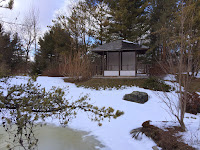The Japanese garden was built in 1988 and is very large. There are sweeping vistas that are populated with many elements of a traditional Japanese garden - stone lanterns, bridges, a peace bell, and structures of various design and size intended to give visitors a restful place for contemplation. There is also a large pavilion which includes a tea room and several small gardens within.
The first time I visited in April of 2015, it was still cold and covered with snow.
I also liked the small pavilion that overlooked the main lake of the garden. The dimensions were very close to the dimensions of my gazebo in my own garden. I know that at some point I will want to replace my temporary gazebo with a more permanent structure, and this Japanes pavilion seemed to fit the style and size of what I would like to build.
The next time I visited, in August 2016, there was not a covering of snow and ice.
The garden is worthy of its reputation as one of the best in North America. The only drawback I could see was that the pond was created by using a large waterproof tarp as its base. Its unfortunate, but in many places along the edge and throughout its clear water, the tarp is visible.
There is also a Tea Garden along the side of the Japanese Pavilion as seen in the summer of 2018:





























































